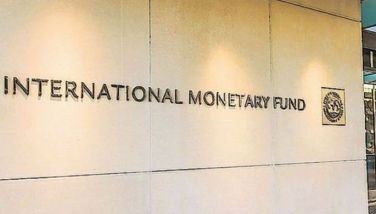Imports plunge sharply due to weak economy
December 20, 2001 | 12:00am
A sharp drop in imports coupled with weakening exports helped boost the country’s October trade surplus to its highest level since February, preserving foreign exchange reserves but indicating a weak economy, analysts said yesterday.
The National Statistics Office (NSO) reported yesterday that imports plunged by 16.9 percent to $2.371 billion in October from $2.854 billion in the same period last year as demand for vital industrial inputs fell sharply due to a slack in manufacturing activity.
October’s drop was the sharpest so far this year after a 15.9 percent fall in September. Exports, on the other hand, tumbled sharply by more than 13 percent to $2.941 billion in October from $3.398 billion in the same period last year, resulting in a surplus of $570 million which was substantially higher than last year’s October surplus of $545 million.
"This looks bad. Although there’s a surplus contributing to a stable peso, consumer spending actually is not doing well. The economy is not expanding," said Jomar Lacson, an analyst of DBS Vickers Securities.
Most Philippine exports are electronics components used as intermediate goods in the export sector. A fall signals that exports will be weak in the succeeding months.
For the 10-month period, imports fell by 4.2 percent to $25.369 billion from $26.482 billion in the same period last year. Exports incurred a sharp 14 percent drop to only $26.875 billion from $31.265 billion last year.
"This brings the year-to-date trade surplus to $1.5 billion, which should help preserve (foreign exchange) reserves," said Charlie Lay, an analyst at 4cast Ltd in Singapore.
Stable foreign exchange reserves supporting the peso will benefit Philippine corporations, many of which are staggering under the weight of dollar-denominated debt, Lacson said.
Government benefits from a stable peso too, because 57.4 percent of the national debt was held in dollars by the end of September.
But Lay added: "Despite coming off a lower base last year, the (October imports) contraction was more severe (than in September), indicating the continued slowdown in domestic demand."
Among the country’s major imports, payments for electronics and components remained the largest at $363.82 million in October, a sharp 37-percent drop from $578.25 million from a year ago.
Purchases of telecommunication equipment and electrical machinery ranked second at $269.60 million followed by mineral fuels, lubricants and related materials with $266.09 million.
Other top imports were: office and EDP machines, $204.55 million; industrial machinery, $116.56 million; transport equipment, $96.15 million and other imported materials, $92.54 million.
By country, Japan emerged as the biggest source of imports with shipments worth $510.49 million followed by the US with shipments valued at $351.64 million.
Other top sources were: South Korea, $175.92 million; Singapore, $152.42 million; Taiwan, $122.69 million; Hong Kong, $102.04 million; China, $78.14 million; and Thailand, $68.96 million.
The National Statistics Office (NSO) reported yesterday that imports plunged by 16.9 percent to $2.371 billion in October from $2.854 billion in the same period last year as demand for vital industrial inputs fell sharply due to a slack in manufacturing activity.
October’s drop was the sharpest so far this year after a 15.9 percent fall in September. Exports, on the other hand, tumbled sharply by more than 13 percent to $2.941 billion in October from $3.398 billion in the same period last year, resulting in a surplus of $570 million which was substantially higher than last year’s October surplus of $545 million.
"This looks bad. Although there’s a surplus contributing to a stable peso, consumer spending actually is not doing well. The economy is not expanding," said Jomar Lacson, an analyst of DBS Vickers Securities.
Most Philippine exports are electronics components used as intermediate goods in the export sector. A fall signals that exports will be weak in the succeeding months.
For the 10-month period, imports fell by 4.2 percent to $25.369 billion from $26.482 billion in the same period last year. Exports incurred a sharp 14 percent drop to only $26.875 billion from $31.265 billion last year.
"This brings the year-to-date trade surplus to $1.5 billion, which should help preserve (foreign exchange) reserves," said Charlie Lay, an analyst at 4cast Ltd in Singapore.
Stable foreign exchange reserves supporting the peso will benefit Philippine corporations, many of which are staggering under the weight of dollar-denominated debt, Lacson said.
Government benefits from a stable peso too, because 57.4 percent of the national debt was held in dollars by the end of September.
But Lay added: "Despite coming off a lower base last year, the (October imports) contraction was more severe (than in September), indicating the continued slowdown in domestic demand."
Among the country’s major imports, payments for electronics and components remained the largest at $363.82 million in October, a sharp 37-percent drop from $578.25 million from a year ago.
Purchases of telecommunication equipment and electrical machinery ranked second at $269.60 million followed by mineral fuels, lubricants and related materials with $266.09 million.
Other top imports were: office and EDP machines, $204.55 million; industrial machinery, $116.56 million; transport equipment, $96.15 million and other imported materials, $92.54 million.
By country, Japan emerged as the biggest source of imports with shipments worth $510.49 million followed by the US with shipments valued at $351.64 million.
Other top sources were: South Korea, $175.92 million; Singapore, $152.42 million; Taiwan, $122.69 million; Hong Kong, $102.04 million; China, $78.14 million; and Thailand, $68.96 million.
BrandSpace Articles
<
>
- Latest
- Trending
Trending
Latest





























